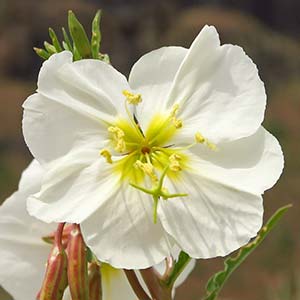Oenothera howardii
Oenothera pallida
Howard's evening-primrose
mountain evening primrose, pale evening-primrose, rockweed brush, white-stem evening primrose
(when present) ascending, longer ones becoming decumbent, leafy, sometimes densely so, 0–10(–30) cm.
erect or ascending, single to several from base, unbranched or many-branched throughout, 10–50(–70) cm.
in a basal rosette, sometimes also cauline, (6–)8.5–17(–23) × (0.5–)1–2(–3) cm;
petiole 2–7.5 cm;
blade usually oblanceolate, elliptic to narrowly oblong, rarely lanceolate, margins often undulate, entire or remotely and irregularly pinnately lobed mostly in proximal 1/2, rarely more regularly pinnately lobed and lobing extending to distal 1/2, sinuses usually extending less than 1/2 to midrib, lobes triangular to oblong or linear, (1–)4–9(–13) mm, apex acute to obtuse.
cauline, rosette usually weakly developed or absent, at least during flowering, sometimes well developed, 1–5(–7.8) × 0.3–1(–1.5) cm;
petiole 0–2(–4.5) cm;
blade lanceolate, oblong, linear-lanceolate, or ovate, margins subentire or remotely denticulate, deeply sinuate-dentate, or pinnatifid, sometimes repand.
usually 1 or 2, rarely more, opening per day near sunset, strongly and sweetly scented;
buds with unequal free tips 1–3(–4) mm;
floral tube (43–)60–110(–125) mm;
sepals (30–)35–60(–80) mm;
petals brilliant yellow, fading deep red, drying deep reddish purple to reddish brown, usually broadly obovate, rarely subrhombic, (30–)40–60(–73) mm, sometimes with a terminal tooth;
filaments (19–)25–38 mm, anthers 10–17 mm;
style(90–)110–145(–165) mm, stigma exserted beyond anthers at anthesis.
1–several opening per day near sunset;
buds nodding, weakly quadrangular, with free tips 0–2 mm;
floral tube 15–40 mm;
sepals 10–30 mm, not spotted;
petals white, fading pink to deep pink, broadly obovate or obcordate, (10–)15–25(–40) mm;
filaments 9–15 mm, anthers 3–10 mm;
style 25–55 mm, stigma exserted beyond anthers at anthesis.
leathery, ovoid, narrowly ovoid, or narrowly lanceoloid to broadly ellipsoid, winged, wings (2–)4–7(–11) mm wide, body (20–)25–50(–80) × 4–6 mm, dehiscent 1/4–1/3 their length;
pedicel 2–6 mm.
spreading to reflexed, straight to curved or contorted, cylindrical, obtusely 4-angled, tapering slightly from base to apex, 15–60 × 1.5–2.5 mm;
sessile.
numerous, usually in 1 row per locule, rarely in 2 rows toward base, obovoid to subcuboid, 3–8 × 2.5–3.5 mm.
numerous, in 1 row per locule, brownish with dark spots or black, narrowly obovoid, 1.5–2.2 mm.
= 28, 42, 56.
Oenothera howardii
Oenothera pallida
Oenotherahowardii is known from three disjunct areas: three collections on the High Plains (Baca and Otero counties, Colorado, and Hamilton County, Kansas); open yucca-juniper grassland, rocky slopes or disturbed areas on shale substrates along the Colorado counties of Boulder, Denver, Jefferson, and Larimer, and just over the state line in Wyoming; and, common to scattered, mostly on rocky slopes but also in shaded canyon sites on fine-textured red sandstones, clays, gypsum, chalky white degraded limestone or limestone in pinyon-juniper woodland to ponderosa pine-Douglas fir forest in southern Utah and eastern Nevada.
A. Nelson intended to publish Lavauxia howardii as a new combination and base it on Oenothera howardii M. E. Jones (1893), which was not validly published at the time, but inadvertently published L. howardii as a new species. Oenothera howardii (A. Nelson) W. L. Wagner is an isonym.
(Discussion copyrighted by Flora of North America; reprinted with permission.)
Subspecies 4 (4 in the flora).
Oenothera pallida is a poorly understood species currently subdivided into four subspecies (W. L. Wagner et al. 2007) that differ largely in aspect, leaf division, capsule configuration, and pubescence. The variation pattern is rather complex with almost no diagnostic character uniformly distinguishing any one of the subspecies. Instead, each of the subspecies, which are mostly geographically separated although there is some level of overlap, have diagnostic suites of characters that maintain their linkage some of the time, but break down across the geographic area of each so that no single character uniquely identifies it. Each subspecies is characterized by leaf, pubescence, and, often, habit features. The issues with the integrity and intergradations of the subspecies are discussed below.
Oenothera pallida has been determined to be self-incompatible (W. L. Wagner et al. 2007), but K. E. Theiss et al. (2010) determined that although most populations of subsp. pallida are self-incompatible, one near Salt Lake City is self-compatible.
(Discussion copyrighted by Flora of North America; reprinted with permission.)
1. Herbs annual, sometimes perennial from a taproot, when perennial, sometimes with lateral roots producing adventitious shoots, strigillose throughout and villous distally, especially on flower parts. | subsp. trichocalyx |
1. Herbs perennial from a taproot and with lateral roots producing adventitious shoots, glabrous, strigillose, or sparsely villous. | → 2 |
2. Plants glabrous, sometimes strigillose, rarely sparsely villous; leaf blade margins usually subentire or remotely denticulate, rarely pinnatifid; capsules usually contorted to curved. | subsp. pallida |
2. Plants usually strigillose, rarely villous or glabrous; leaf blade margins shallowly sinuate-dentate or denticulate, or deeply sinuate-dentate to pinnatifid, rarely only dentate; capsules usually straight or curved, sometimes contorted. | → 3 |
3. Leaf blades (0.4–)0.7–1.5 cm wide, margins shallowly sinuate-dentate or denticulate. | subsp. latifolia |
3. Leaf blades 0.4–1(–1.5) cm wide, margins usually deeply sinuate-dentate to pinnatifid, rarely dentate only. | subsp. runcinata |


